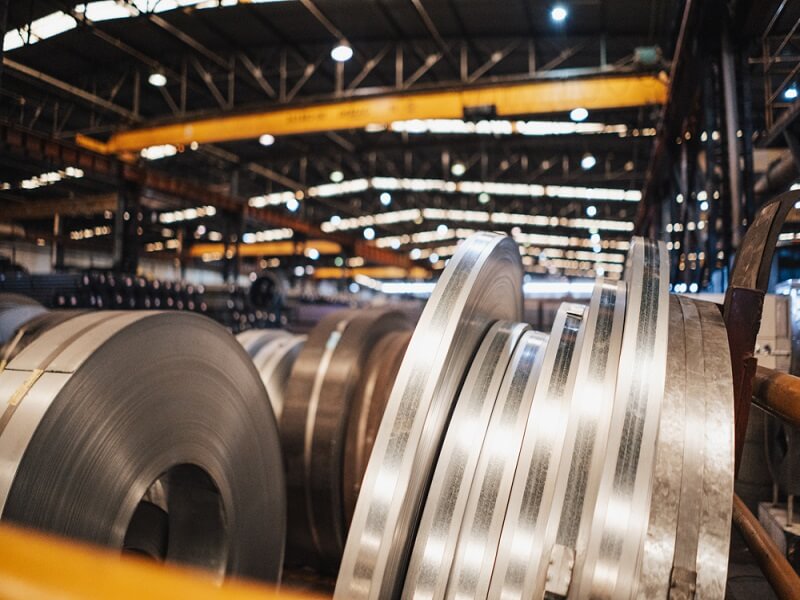
Galvanized steel is a versatile tool in a variety of sectors and applications. And it's no coincidence. This type of material has several essential properties to ensure results tailored to your needs.
Therefore, it's worth understanding this material better and learning about the main characteristics of this galvanized steel pipe or sheet, as it could be the solution you need for your project. Learn more below!
Galvanized steel is considered a type of steel with a zinc coating to protect it from corrosion. In other words, galvanizing is a process in which steel is immersed in a bath of molten zinc or coated with zinc through other methods, such as electroplating.
The coating provides a durable protective layer to the steel, making it resistant to rust caused by environmental factors such as moisture, oxygen, and chemicals. Zinc acts as a physical barrier between the steel and the environment, preventing the metal from coming into direct contact with corrosive agents.
THE origin of galvanized steel dates back to the 19th century. The galvanizing process was developed as a technique to protect steel from corrosion. French inventor and scientist Stanislas Sorel is credited with pioneering the discovery of the hot-dip galvanizing process.
In 1837, Sorel patented the method of dipping iron in molten zinc to create a protective zinc coating on the metal. This technique was named galvanization after Luigi Galvani, an Italian scientist known for his studies in electricity and electrochemistry.
Hot-dip galvanizing has become popular and widely used for corrosion protection of steel in a variety of industrial applications.
Over time, the hot galvanizing process has been improved and become more efficient, expanding the application of galvanized steel in different sectors.
Over the years, cold galvanizing techniques have also been developed. This method involves applying a zinc coating to steel through electrochemical processes such as electrodeposition.
Since then, galvanized steel has become a widely used material in a variety of segments, due to its properties of corrosion resistance and durability.
Because it is strong and durable, galvanized steel is suitable for use in a wide variety of applications.
Galvanized steel is used in several stages of construction, such as in the manufacture of metal structures, beams, pillars, profiles, panels, gratings, handrails, screws, and galvanized steel tiles. It offers corrosion resistance, increasing the lifespan and safety of structures.
It's widely used in the manufacture of automotive parts, such as car bodies, chassis, suspension components, and exhaust systems. It helps protect vehicles against the effects of corrosion caused by adverse weather conditions and environments.
It's also used in the production of home appliances such as refrigerators, stoves, and washing machines and dryers. It provides a surface resistant to corrosion and wear, as well as a pleasing aesthetic appearance.
When it comes to infrastructure, galvanized steel is used in bridges, viaducts, walkways, lighting poles, guardrails, and drainage systems. It's ideal for outdoor environments where exposure to harsh weather conditions is intense.
Galvanized pipes are easy to clean, a significant advantage in sugar and ethanol plants. They play an essential role in the cooking and evaporation processes, contributing to efficient operation.
It covers the structures of power transmission towers, solar panel supports, wind turbines, and other components related to power generation and transmission. Zinc coating helps protect the steel from the corrosive effects of the environment.
It's widely used in agricultural equipment such as storage silos, fences, gates, irrigation pipes, and animal shelter structures. It provides corrosion protection in harsh agricultural environments.
Galvanized steel provides greater safety for transported fluids, preventing internal corrosion and scale formation due to its low roughness. It's also ideal for transporting and handling chemicals, ensuring a long service life.
There are different types of galvanized steel piping. The choice depends on its purpose and whether the supplier is certified and standardized. quality of parts. Check out some examples below.
This type of galvanized steel pipe is manufactured from a medium-carbon alloy. The addition of carbon to the alloy gives the material greater strength and hardness, making it suitable for applications requiring greater mechanical strength, such as gears, machine parts, and railways.
They are made from a high-carbon alloy, which makes them even stronger and harder than medium-carbon alloy tubes.
These pipes are used in applications requiring high mechanical strength and are commonly found in support structures, fluid transmission systems and high pressure applications.
Galvanized pipes stainless steel combine the corrosion resistance properties of stainless steel with the additional protection provided by zinc plating.
Therefore, they are highly resistant to corrosion in aggressive environments and are widely used in the chemical, petrochemical and food industries.
It is made from a duplex stainless steel alloy, consisting of approximately 22% of chromium, 5% of nickel, and 3% of molybdenum. This alloy offers excellent corrosion resistance, high mechanical strength, and good toughness.
2205 steel pipes are widely used in applications requiring high corrosion resistance, such as chemical industries.
It is developed from ferritic stainless steel, which contains approximately 17% of chromium. While not as corrosion resistant as duplex or austenitic stainless steel alloys, 430 offers good corrosion resistance in less aggressive environments.
In this sense, they are mainly used in applications where corrosion resistance is less critical, such as automobile exhaust systems and architectural applications.
Galvanized steel is widely used in a variety of applications; you just need to find the ideal type for your project, based on the properties you need. At Grupo Aço Cearense, for example, you'll find galvanized steel sheets, coils, profiles, pipes, and tiles.
Want to learn even more and access high-quality materials? Then read on. other content on the blog, check out our portfolio and request your quote from the Ceará Steel Group!